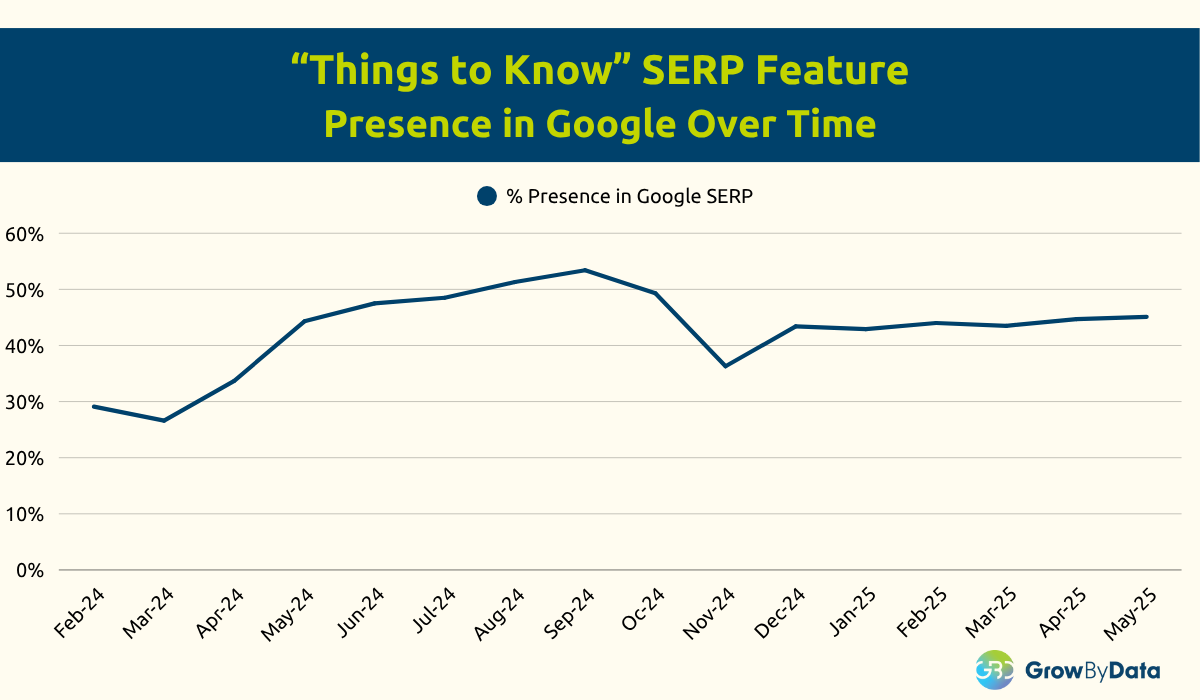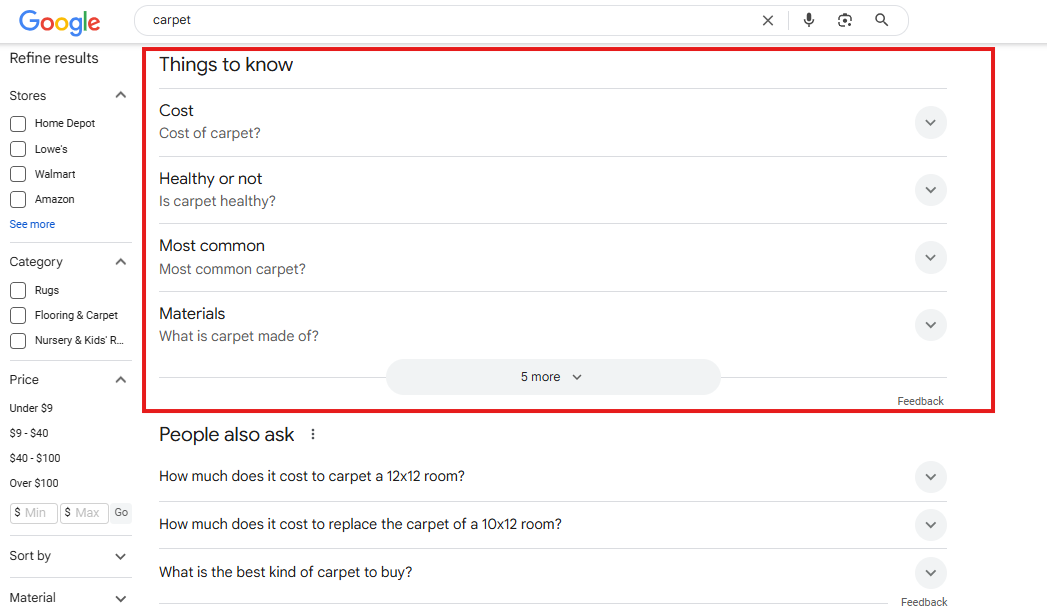Google is constantly evolving how it presents information in search results. “Things to Know” SERP feature can be considered as a valuable additions on Google SERPs, and optimizing for this feature can be valuable opportunities for Marketers and SEO Professionals if their goal is to boost visibility and authority.
Introduced by Google in September 2021, “Things to Know” feature has gradually been reshaping how information is explored on Google. Even in 2025, Google is continuing to experiment with this feature and rolling it out more broadly within certain industries such as Healthcare, Automotive, technology and so on.
Even from 2024, Things to Know had a modest presence of around 29.1% in February 2024, it has since expanded meaningfully across industries. As of May 2025, its highest presence has climbed as high as 45.1%, with particularly strong adoption in information-rich sectors like healthcare (currently appearing 69.5% of the time for healthcare queries). Its growing footprint underscores its strategic importance in SEO and content planning. As it’s SERP presence stabilizing over 43%, this feature is affirming its role in shaping the user engagement with SERP content.

Here’s everything you need to know about this feature.
What is the Google “Things to Know” SERP Feature?
Google “Things to know” feature is an expandable section that appears on Google search result page and can be categorized as an organic SERP feature. This feature presents concise sub-topics relevant to the query and each sub-topics offers a brief overview of the sub-topics. These brief summaries assists users in navigating the sub-topic more effectively. If clicked, the sub-topic expands to display additional detailed information.
For example, searching for “carpets” may bring up follow-up sub-topics/suggestions like “Cost: Cost of carpet”, “Healthy or not: Is carpet healthy” or “Most common: Most common carpet?” Clicking on a subtopic expands it to show more in-depth content, often linking to external websites. This feature may look like “People Also Ask” visually but there is subtle difference as People also ask displays simple list of FAQ queries which are expandable with brief answer and link to the source.

Here is an interesting facts regarding the results under sub-topics. We are seeing different form of information.
- AI-generated summary labeled as “AI Overview,” and showing 3 different sources.
- Direct answer & summary extracted from a source along with its link.
- Number of source presented in a listicle pattern with logo, title, description and image.
Think of it as Google’s version of a preemptive FAQ—designed to enhance the search experience through curated, relevant insights. When you look into the data from GrowByData, this feature can be considered as a popular SERP features in 2025.
| SERP Feature (Top 10) | Presence | SERP Feature | Presence |
|---|---|---|---|
| Organic | 100% | Things to Know | 42.7% |
| People also ask | 93% | Images | 36.2% |
| People Also Search | 86.1% | AI Overview | 34.3% |
| Refinement Bubbles | 53.3% | Knowledge Panel | 32.1% |
| Merchant listings | 45.5% | Explore Brands | 31.3% |
Where Is It Most Commonly Seen?
Based on GrowByData SERP tracking data, the “Things to know” feature has been observed across a range of industries:
If you’re in healthcare or automotive, this feature could be capturing a significant share of your search visibility. Even in sectors like finance and retail, its presence is noticeable — and growing.
| Industry | Desktop Presence (%) |
|---|---|
| Healthcare | 61.6% |
| Beauty | 51.7% |
| Home Furnishing | 14.4% |
| Apparel | 9.91% |
Why “Things to Know” Matters for SEO
Being featured in the Google “Things to Know” section offers some key advantages:
- Establishes your brand as an reliable and trusty source, even in cases of zero-click searches.
- As mentioned above, ranking on this feature can be a winning formula for getting exposure in LLMs platform like ChatGPT, gemini and others.
→ Monitor your LLM Brand Citation
This feature presents an ideal opportunity for top-of-funnel content strategies, especially if your focus is on educating users or providing helpful insights.
How GrowByData helps marketer track Things to Know?
We help and equips marketers with right platform to track, measure and optimize their search strategy with a specific industry or topic.
- Track this SERP feature effortlessly with granular SEO and AI insights.
- Empower Business like yours to analyze SERP presence trends.
- Track and Analyze competitors performance for ranking for this feature.
→ Monitor Things to Know and its presence
How to Optimize for “Things to Know”
To increase your chances of appearing in the “Things to Know” SERP feature, follow these key strategies:
1. Cover Related Subtopics Clearly
Structure your content with descriptive subheadings that align with common queries, such as “What is [topic]?”, “How does [topic] work?”, “Benefits of [topic]” and so on.
2. Use heading tags for each Sub-topics
Optimize and structure your content with question based heading tags for each Sub-topics.
3. Provide Concise and definitive answers
Answer each sub-topic with simple, and concise way in a 2-4 sentences.
4. Add Structured Data
Implement schema markup (e.g., FAQPage, HowTo) to enhance your content’s eligibility for SERP features and improve its visibility.
→ Tips & Advice for Optimizing for 5 TOP SERP Features
Conclusion: It’s Time to Adapt
The “Things to Know” SERP feature is part of Google’s broader shift toward more intuitive, intent-based search experiences. For marketers, it presents both a challenge and an opportunity: a chance to be discovered in new ways, or risk being overlooked entirely.
At GrowBydata, we’re constantly decoding every shift in the SERP — so you don’t have to. If your rankings feel off or your conversions are lagging, you’re not imagining it. Let’s make sense of what’s changing — and how to stay ahead in the evolving search landscape.



